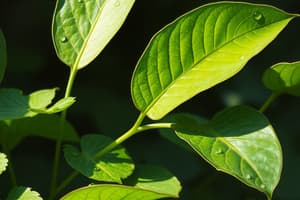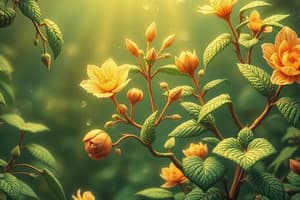Podcast
Questions and Answers
Where does most photosynthesis take place in a leaf?
Where does most photosynthesis take place in a leaf?
- Veins bringing water and minerals to the leaf
- Stomata on the leaf surface
- Palisade cells near the top of the leaf (correct)
- Spongy mesophyll layer at the bottom of the leaf
How do plant cells store glucose for respiration at night?
How do plant cells store glucose for respiration at night?
- By storing it as soluble molecules
- By converting it into oxygen
- By releasing it through stomata
- By converting it into starch (correct)
What is the function of phloem tubes inside veins in a leaf?
What is the function of phloem tubes inside veins in a leaf?
- Regulating water and mineral intake
- Transporting glucose to cells that can't make their own (correct)
- Releasing oxygen into the atmosphere
- Absorbing light energy for photosynthesis
How does pondweed obtain carbon dioxide for photosynthesis?
How does pondweed obtain carbon dioxide for photosynthesis?
What causes the spare oxygen released during photosynthesis in pondweed to form bubbles in the water?
What causes the spare oxygen released during photosynthesis in pondweed to form bubbles in the water?
Study Notes
Photosynthesis in Leaves
- Most photosynthesis occurs in the mesophyll layer of the leaf, specifically the chloroplast-rich palisade mesophyll cells. This area is well-positioned for maximum light absorption.
Glucose Storage in Plant Cells
- Plant cells store glucose as starch molecules. Starch serves as a compact energy reserve, which can be broken down into glucose during respiration at night when photosynthesis ceases.
Function of Phloem Tubes
- Phloem tubes transport the organic compounds, primarily glucose, produced during photosynthesis from the leaves to other parts of the plant. This distribution is crucial for energy availability throughout the plant.
Carbon Dioxide Acquisition in Pondweed
- Pondweed absorbs carbon dioxide (CO2) from the surrounding water, where it dissolves, facilitating the photosynthesis process. The aquatic environment provides a consistent supply of this essential gas.
Oxygen Release during Photosynthesis
- The excess oxygen produced as a byproduct of photosynthesis in pondweed bubbles up and forms gas bubbles in the water. This occurs as a result of water splitting during the light-dependent reactions, generating oxygen as a waste product.
Studying That Suits You
Use AI to generate personalized quizzes and flashcards to suit your learning preferences.
Description
Test your knowledge of leaf structure and photosynthesis with this quiz. Explore the functions of chloroplasts, palisade cells, veins, xylem, and the process of carbon dioxide diffusion in leaves.




